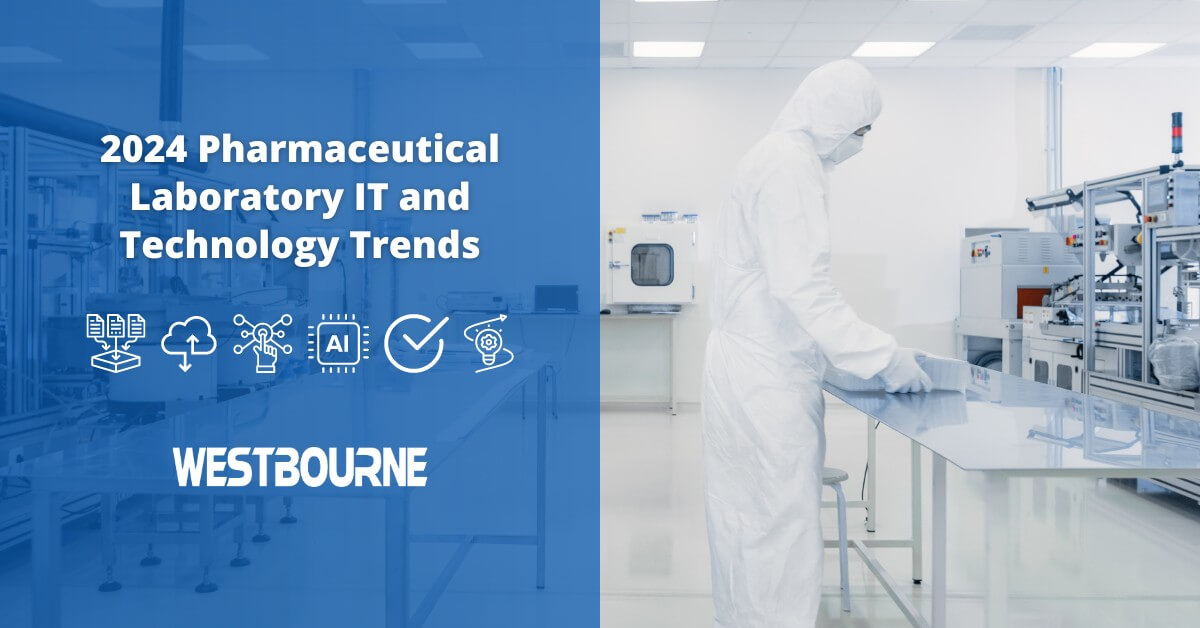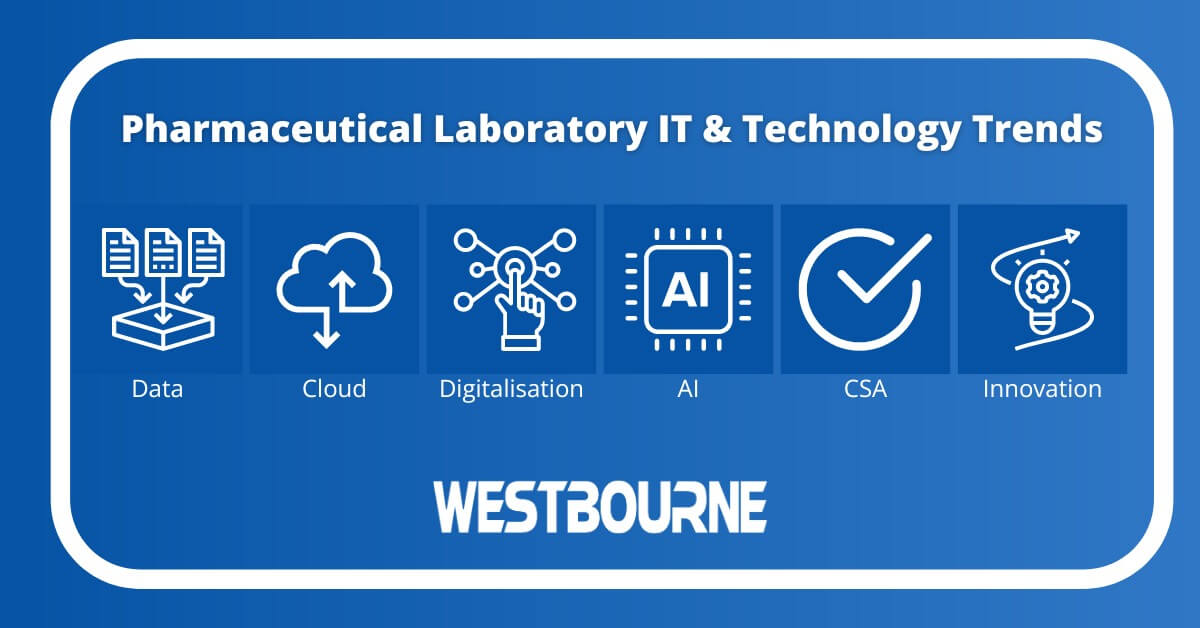2024 Pharmaceutical Laboratory IT and Technology Trends

Digitalization, Industry 5.0, smart manufacturing, and Quality 5.0 are buzzwords that will continue to have significant meaning in 2024 as pharmaceutical businesses strive for growth and drive innovation. Laboratories play a significant role in the success of any pharmaceutical manufacturing operation, so what are the trends to be aware of to ensure your lab keeps up with the necessary pace of change?
In this blog, we are going to focus specifically on the laboratory IT and technology trends that will dominate decision-making in 2024, as lab IT and technology are our areas of expertise here at Westbourne IT.
We also have considerable regulatory and compliance expertise – you can read our blog on 2024 regulatory trends here.
Laboratory IT and Technology Trends for the Pharmaceutical Industry

Data Management and Analytics
Putting data to use and extracting maximum benefit from data is one of the big focus areas for many pharmaceutical organisations. It is a multi-faceted topic that has applications across all areas of business, including manufacturing, supply chain management, quality control, laboratory operations, and compliance.
Given the broad scope of data management and analytics, in addition to the nature of pharmaceutical manufacturing operations (legacy systems, fragmented datasets, inconsistent standards, etc), this is an area of technology and IT that is a journey rather than a single-point solution.
Therefore, the trend in 2024 is that pharmaceutical laboratories will continue on their data management and analytics journeys, implementing strategies and projects that achieve key milestones. Examples include:
- Introducing or upgrading modern technologies such as LIMS
- Integrating systems and improving connectivity
- Eliminating manual data entry and processing
- Creating data standards and implementing solutions that ensure data is structured
- Developing data dashboards and reports that deliver meaningful insights and enable data-driven decision-making
Cloud Migration and IT Modernization
There are a number of factors that are driving cloud migration and IT modernization projects in pharmaceutical laboratories. Some examples include:
- Cost pressures, especially in relation to the cost (and cost complexity) of hardware and licensing.
- Versions of Microsoft Windows and other key software applications nearing end-of-life deadlines.
- User experience and the push to ensure technology facilitates productivity and innovation by minimizing situations where technology gets in the way.
- The growing importance of bridging the IT and OT (operational technology) gap.
Throughout 2024 and beyond, pharmaceutical laboratories will continue to explore opportunities in cloud technologies, Windows 11 migrations, and infrastructure modernization and consolidation.
Increasing Pace of Digitalization
The pace of digitalization in pharmaceutical laboratories is also likely to increase in 2024. Digitalization solutions and technologies are helping pharmaceutical companies to become more productive and efficient. Digitalization also helps companies overcome the challenges that currently exist in the industry, from skills shortages to increasing transparency requirements from regulators.
Artificial Intelligence (AI)
All companies are exploring the potential uses of AI, and there is considerable excitement about the possibilities for the pharmaceutical industry, especially in areas like product research and development. AI as part of the evolution into Industry 5.0 will also play an increasingly important role in the day-to-day tasks of pharmaceutical manufacturing, supply chain management, and quality control.
As a result, the use of AI will be a trend throughout 2024 and beyond but there is another AI-related trend that is also important – ensuring the use of AI in the pharmaceutical industry is responsible and ethical. Debates and discussions on these topics will be a feature of the coming months and years.
Computer Software Assurance
The validation of computer equipment and software applications in the life sciences sector is changing with the publication by the FDA in 2022 of its draft CSA (computer software assurance) guidance. As a result, we will see more and more pharmaceutical operations transitioning away from the traditional CSV (computer software validation) method of validation to CSA and its risk-based, critical-thinking approach. Read more about transitioning from CSV to CSA on our blog.
Adaptability and Process Innovation
There are game-changing innovations taking place in the pharmaceutical industry that are set to have a transformative effect on patient care and health outcomes. A few examples include personalized medicines, the growing use of cell and gene therapies, and the development of new combination products that include both medical devices and pharmaceutical products.
Laboratory operations will need to evolve and adapt to ensure processes and procedures keep up with the pace of change. Technology solutions will play an important role in the evolution of the pharmaceutical industry and laboratory operations.
Continuous Improvement for Today and Tomorrow
The changes taking place as the pharmaceutical industry transitions from Industry 4.0 to Industry 5.0 aim to improve the efficiency and effectiveness of drug discovery, development, and distribution, with a strong emphasis on patient safety, compliance, productivity, employee wellbeing, and profitability. This includes the changes highlighted by the trends described above.
Staying on top of these trends and continuing to develop and improve the use of technology and data are essential for pharmaceutical organizations.
Latest Insights
Why Multidisciplinary Skills Are Essential in Pharma Lab and Manufacturing Operations
Very specific skills are required to successfully, safely, and profitably run a pharmaceutical manufacturing and laboratory operation. We are in an era of change, however. This means skills requirements are also changing, with multidisciplinary skills coming to the...
How On-Site IT Engineers Become Enablers in Your Organisation
There are many technical issues and tasks that can be supported by remote teams. Others, however, require the physical...
The GxP Implications of Windows 10 End-of-Life for Pharma Labs
Windows 10, the commonly used operating system in pharmaceutical laboratories, is reaching its end-of-life (EOL). The...
Maximizing Pharmaceutical Digital Transformation ROI
Digital transformation is changing the way pharmaceutical companies run their businesses, manufacture products, and...
Understanding Process Validation in the Pharmaceutical Industry
Process validation is all about two essential requirements for manufacturing in the pharmaceutical industry:...

